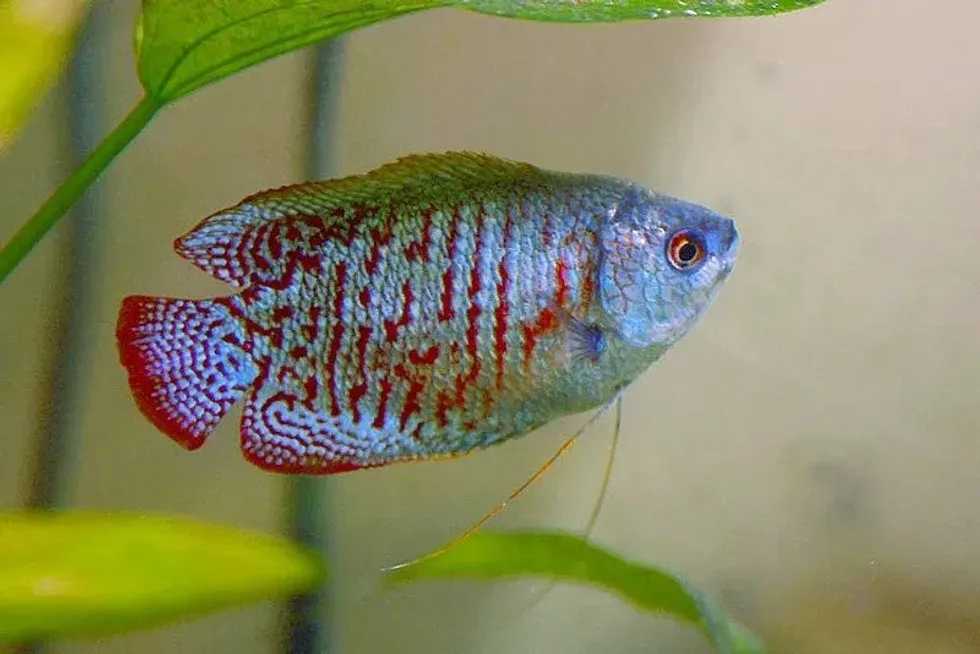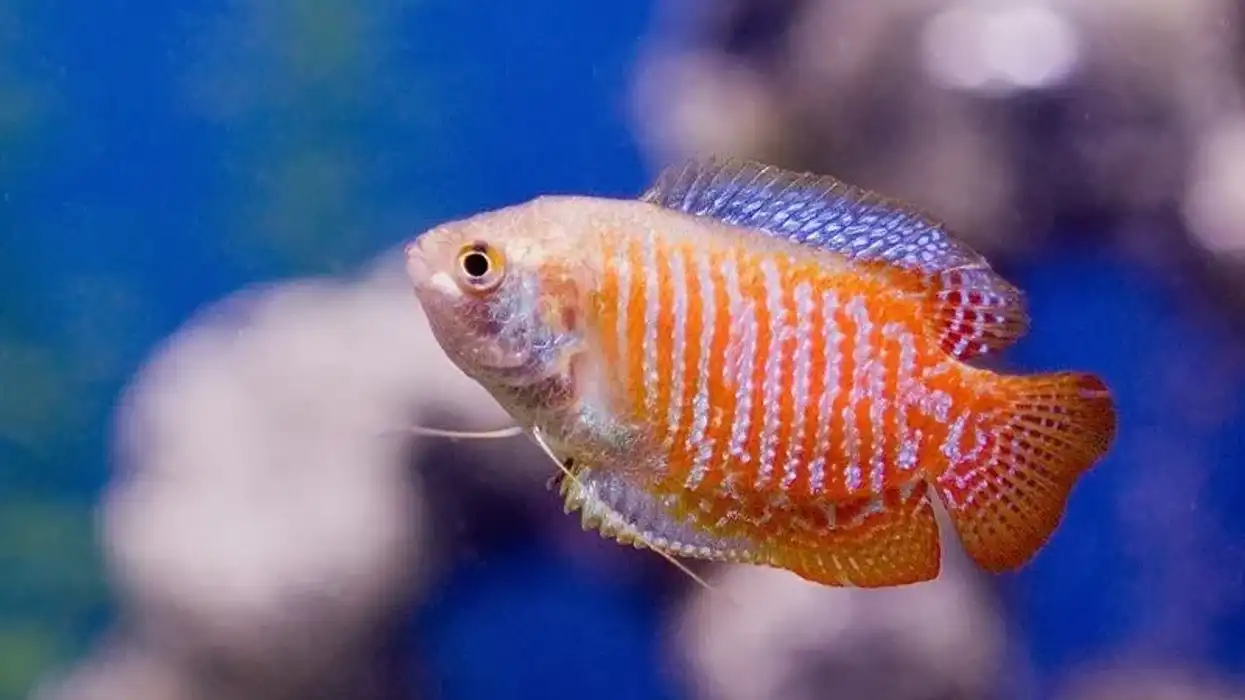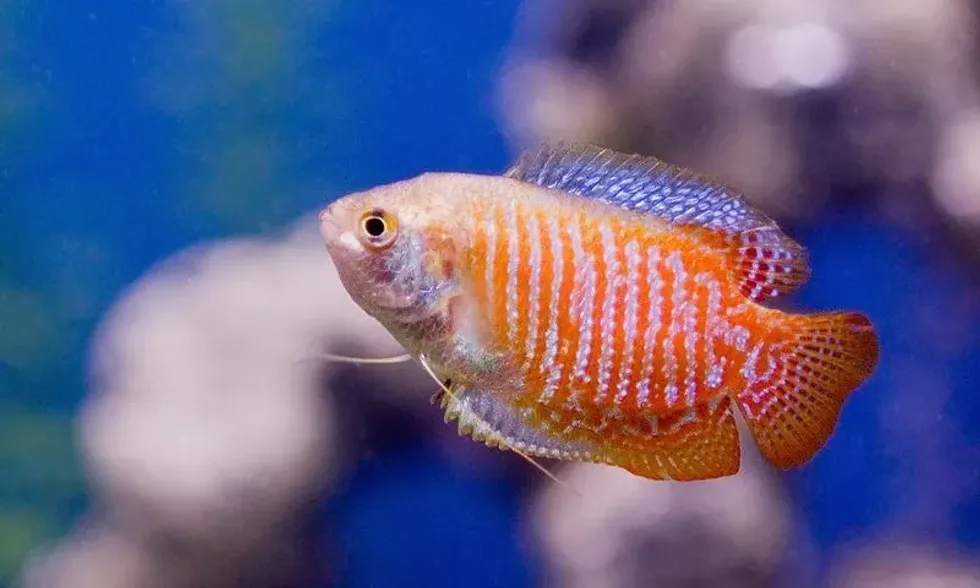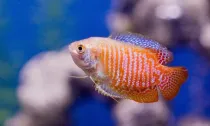Fun Dwarf Gourami Facts For Kids

Content
- What type of animal is a dwarf gourami?
- What class of animal does a dwarf gourami belong to?
- How many dwarf gouramis are there in the world?
- Where does a dwarf gourami live?
- What is a dwarf gourami's habitat?
- Who does the dwarf gourami live with?
- How long does a dwarf gourami live?
- How do they reproduce?
- What is their conservation status?
- What does a dwarf gourami look like?
- How cute are they?
- How do they communicate?
- How big is a dwarf gourami?
- How fast can a dwarf gourami swim?
- How much does a dwarf gourami weigh?
- What are the male and female names of the species?
- What would you call a baby dwarf gourami?
- What do they eat?
- Are they dangerous?
- Would they make a good pet?
- Did you know...
- What kind of temperament does dwarf gourami have?
- What fish do dwarf gouramis get on with?
Are you interested in keeping aquarium fish? If yes, then you might know about the gouramis that are a popular option.
Among all the different types of gourami species, the dwarf gourami does stand out because of its small size and beautiful color morphs.
This is one of the smallest gourami species available, and in its native habitat, it lives in various water bodies like lakes, rivers, and streams. The male fish is known for building bubble nests close to floating plants that house the eggs until the hatching occurs.
Moreover, dwarf gourami care is quite easy, so even the kids can have it as their first pet fish. All you will need to do is to provide a comfortable tank to the fish that has the right water conditions along with lots of plants.
In the wild, gouramis have a varied diet which includes materials from plants and animals. But, while keeping the fish in a tank, you can give it brine shrimp, bloodworms, usual fish pellets to keep it healthy.
You can even keep these fishes in a community tank, and people visiting the place will be interested in knowing more about this shiny fish. So, keep reading for more dwarf gourami facts.
Also, check out the articles on frilled sharks and bowfin to learn about taking care of various fish species.
Dwarf Gourami Interesting Facts
What type of animal is a dwarf gourami?
The dwarf gourami is a species of gourami that is known for being a common aquarium fish.
What class of animal does a dwarf gourami belong to?
The dwarf gourami belongs to the class Actinopterygii and to the family Osphronemidae.
How many dwarf gouramis are there in the world?
There is no conclusive data about the exact population of this species, but it's said that a significant amount of the wild population is found in Assam, India.
Where does a dwarf gourami live?
In the wild, the dwarf gourami is found in the Indian subcontinent, mainly in the countries of India, Pakistan, and Bangladesh. However, you can find this fish worldwide because of its popularity as an aquarium fish.
What is a dwarf gourami's habitat?
Dwarf gouramis are a free-swimming fish species that prefer freshwater habitats such as rivers, streams, rivulets, lakes that have plenty of plants and vegetation. When you keep the fish in an aquarium, it's important to maintain water parameters that are similar to its native habitat. The first step includes choosing a proper tank size for the fish.
The minimum tank size for dwarf gourami should be around 10 gallons, and after that, you can add around four to five gallons for each additional fish. Some people go for the minimum tank size of five gallons which is wrong, and when many fish are kept in a small tank, individuals become aggressive.
Also, make sure to have many live plants in the aquarium as it would help the fish to breathe air and work as an additional filter for the water.
When it comes to the conditions of the aquarium, you should strive to keep the water temperature between 72-82° F (22–27° C). The pH level of the water should be around 6-7.5, while the water hardness level should be within 4-10 dGH.
Always remember to install a good quality filter to keep the water oxygenated and clean. Every week you should diligently change 10-20% of the aquarium water to take care of the ammonia levels.
Who does the dwarf gourami live with?
In the wild, gouramis live together in small groups. However, as this is a peaceful aquarium fish species, you can keep the dwarf gourami in a community tank. It prefers to occupy the middle layer of the tank and even hide behind plants. Just make sure that there's enough space for everyone so that everyone is healthy and thriving.
How long does a dwarf gourami live?
The lifespan of the dwarf gourami is around four years, and with good care, the fish can live its full life. Keep checking the nitrate levels in a gourami tank, as an overpowering amount of nitrates can bring down the lifespan of this fish.
How do they reproduce?
One of the most interesting things about the dwarf gourami is its way of breeding. It's easy to breed the dwarf gourami, even in an aquarium.
The best way to do it is by keeping some male and female gouramis in a tank with a low water level. And, keep the temperature at about 82 F (27.7 C). Male gouramis are the ones that build those famous bubble nests where the eggs are housed.
You have to provide nest building materials to the fish, and the best way is to install plants into the space. The males will also prepare the nest even before the breeding has started.
When the male of the species is ready for breeding, it tries to woo the female for mating. If the female really likes the male, she will also join in the dance.
While spawning, the female may release several dozens of clear eggs, and the number is about 600 eggs. As soon as the female releases the eggs, the male releases its sperm to fertilize the eggs that will then swim to the top.
You can add floating plants to the tank to help the male make the bubble nests.
The breeding pair may spawn multiple times, and the male may even form breeding pairs with other females in a tank. Males will also swim up to the tank's surface to seal the bottom of the bubble nests so that the eggs don't go astray.
It's important to remove the females after the breeding is over to protect the eggs. However, the male fish would remain in the tank to take care of the eggs, which hatch after about 12-24 hours.
By the third day, the fry swims around the tank, and this is the time to remove the male from the tank. The diet of the fry can include fry feed and infusoria. And, after the week is over, brine shrimp can be added to the diet of the young gourami fish.
What is their conservation status?
According to observations made by the International Union for Conservation of Nature (IUCN) Red List, dwarf gouramis have been classified under the status of Least Concern.
Dwarf Gourami Fun Facts
What does a dwarf gourami look like?

The first thing that we need to tell you about this species of gourami fish is that there are different dwarf gourami types, which are mainly decided on the various colors that the fish might have.
The common color variants include the neon blue dwarf gourami, the powder blue dwarf gourami, flame dwarf gourami, the usual blue gourami dwarf, and many more.
All of these are quite popular in the aquarium market.
We especially like the flame dwarf gouramis because of the bright orange color, which gives them a similar look to amber tetras. There's also the rainbow dwarf gourami that has bright blue and red stripes on its body.
Dwarf gouramis have a small flattened body, and the fish has big broad fins on the sides of its body.
The anal and dorsal fins of this fish are fused, and the ventral fins have mutated to become filiform outgrowths that help the first in catching sensory inputs. One way to identify the male fish from the female is by looking at the dorsal fin, as the male dwarf gouramis tend to have longer and pointed dorsal fins.
In the wild environment, the color schemes of these gouramis are quite different as the male dwarf gouramis may have alternating blue and red stripes on its body, while the females are more silver and dull.
How cute are they?
Dwarf gouramis are just as cute as honey gouramis, and you should aim to collect the color morphs that you like the best.
How do they communicate?
One of the most mysterious things that we still have to uncover is the way that fish communicate. It has been theorized that fishes can communicate through smell, electrical impulses, and even with the help of different light conditions. However, gouramis are said to have really good hearing abilities that let the fish perceive its environment.
How big is a dwarf gourami?
The average dwarf gourami size is around 2-4 in (5-10 cm). It's considered to be one of the smallest species of gouramis. In comparison, the three-spot gourami attains an average size of around 5.9 in (14.9 cm), making it slightly bigger.
How fast can a dwarf gourami swim?
We don't know much about the speed of this free-swimming fish. It doesn't like turbulent water, and the fish will take time acclimatizing to such situations.
But, if you notice that your pet gourami is erratically swimming around in the tank, then it might be because of stress. It's best to immediately consult an expert or vet to know more about dwarf gourami care.
How much does a dwarf gourami weigh?
We don't know about the weight of this species of gourami, but we can guess that it wouldn't be much as it has a small body. But, there are some gouramis that can reach an average weight of up to 20 lb (9 kg).
What are the male and female names of the species?
There are no sex-specific names for the male and female of this fish species. The dwarf gourami male tends to be larger than the female.
What would you call a baby dwarf gourami?
Like other fishes, the dwarf gourami babies are known as fry.
What do they eat?
The dwarf gourami's diet in the wild may include both plant and animal matter. When kept in the tank, the dwarf gourami will eat the usual pellets and flakes.
And, some people also like to give it live foods such as bloodworms and brine shrimp. Make sure to keep an eye on the diet of your fish, as it's important to keep everyone healthy in the tank.
The diet of your dwarf gouramis can also include freeze-dried food, vegetable pellets, and frozen foods. And, if you are trying to breed a pair of dwarf gouramis, then live foods can be used to bond the male with the female.
Are they dangerous?
No, these small aquarium fish aren't dangerous to anyone and don't harm or kill any other fish. Some species of gouramis, especially the giant gourami, are even eaten by humans.
Would they make a good pet?
Yes, keeping the dwarf gourami as a pet is excellent, and the species is also easily available.
You can get a big tank of 20-30 gal (75.7-113.5 l) and keep five or more fishes in the tank as dwarf gouramis thrive when kept together.
You may or may not keep the fish in pairs, but make sure that every fish has enough space in the tank. However, your fish will end up spending a little bit of lonely time even when kept in pairs.
Along with the right temperature and water hardness, you should also make sure that the water flow of your tank isn't too much, as the dwarf gourami likes slow flow water, which allows it to swim up to the tank's surface.
Did you know...
Dwarf gouramis are a type of labyrinth fish that have a special organ that allows them to take in oxygen from the surface of the tank. This labyrinth organ is quite similar to our lungs.
One of the unfortunate things that are seen amongst these fish species is the dwarf gourami disease. It's considered to be a viral disease that doesn't have a cure.
This disease mainly takes place in commercially bred dwarf gouramis and can quickly spread around the tank. In most cases, the water conditions of the tank are really bad, which leads to this disease.
This disease is caused when an iridovirus attacks the spleen and kidneys of the fish, and within a little while of discovery, your pet can drop dead.
But, the disease actually lasts in the body of the fish for over a month and causes its body to collapse. A tell-tale sign of the disease is a pale look in your fish, and at times it may also swim frantically.
The dwarf gourami disease is viral in nature, so you have to make sure to get other fishes out of the water if there has been a suspected death. As it's not curable, the best way to prevent it is by keeping the tank clean and tidy.
You should add a lot of plants to a dwarf gourami tank as this fish can often get spooked and are in need of a hiding place.
What kind of temperament does dwarf gourami have?
The gourami dwarf is known for having a peaceful temperament, and it doesn't really bother any of its tank mates. Having said that, if too many male fishes are kept in the same tank, then it may lead to aggression. So, make sure to choose a tank size proportionate to the number of gouramis you are planning to get.
What fish do dwarf gouramis get on with?
Dwarf gourami is a peaceful fish so that it can be included in a community tank. But, what you should be aware of is that some fish species can end up bullying the dwarf gourami.
Hence, while setting up a tank, you should be careful about selecting the correct tank mates. The appropriate dwarf gourami tank mates are tetras, loaches, catfish, swordtail fish, rasboras, and mollies. And, at all costs, you should avoid putting the fish with tank mates like Oscars, bettas, African cichlids, and Arowana.
Here at Kidadl, we have carefully created lots of interesting family-friendly animal facts for everyone to discover! Learn more about some other fish from our flounder facts and arapaima facts pages.
You can even occupy yourself at home by coloring in one of our free printable Easy Fish coloring pages.
Main image by Jvarszegi.
Second image by Debivort.
We Want Your Photos!
More for You
See All
Bachelor of Arts and Law specializing in Political Science and Intellectual Property Rights

Anusuya MukherjeeBachelor of Arts and Law specializing in Political Science and Intellectual Property Rights
With a wealth of international experience spanning Europe, Africa, North America, and the Middle East, Anusuya brings a unique perspective to her work as a Content Assistant and Content Updating Coordinator. She holds a law degree from India and has practiced law in India and Kuwait. Anusuya is a fan of rap music and enjoys a good cup of coffee in her free time. Currently, she is working on her novel, "Mr. Ivory Merchant".
Disclaimer
1) Kidadl is independent and to make our service free to you the reader we are supported by advertising. We hope you love our recommendations for products and services! What we suggest is selected independently by the Kidadl team. If you purchase using the Buy Now button we may earn a small commission. This does not influence our choices. Prices are correct and items are available at the time the article was published but we cannot guarantee that on the time of reading. Please note that Kidadl is a participant in the Amazon Services LLC Associates Program, an affiliate advertising program designed to provide a means for sites to earn advertising fees by advertising and linking to Amazon. We also link to other websites, but are not responsible for their content.
2) At Kidadl, we strive to recommend the very best activities and events. We will always aim to give you accurate information at the date of publication - however, information does change, so it’s important you do your own research, double-check and make the decision that is right for your family. We recognise that not all activities and ideas are appropriate for all children and families or in all circumstances. Our recommended activities are based on age but these are a guide. We recommend that these ideas are used as inspiration, that ideas are undertaken with appropriate adult supervision, and that each adult uses their own discretion and knowledge of their children to consider the safety and suitability. Kidadl cannot accept liability for the execution of these ideas, and parental supervision is advised at all times, as safety is paramount. Anyone using the information provided by Kidadl does so at their own risk and we can not accept liability if things go wrong.
3) Because we are an educational resource, we have quotes and facts about a range of historical and modern figures. We do not endorse the actions of or rhetoric of all the people included in these collections, but we think they are important for growing minds to learn about under the guidance of parents or guardians.







